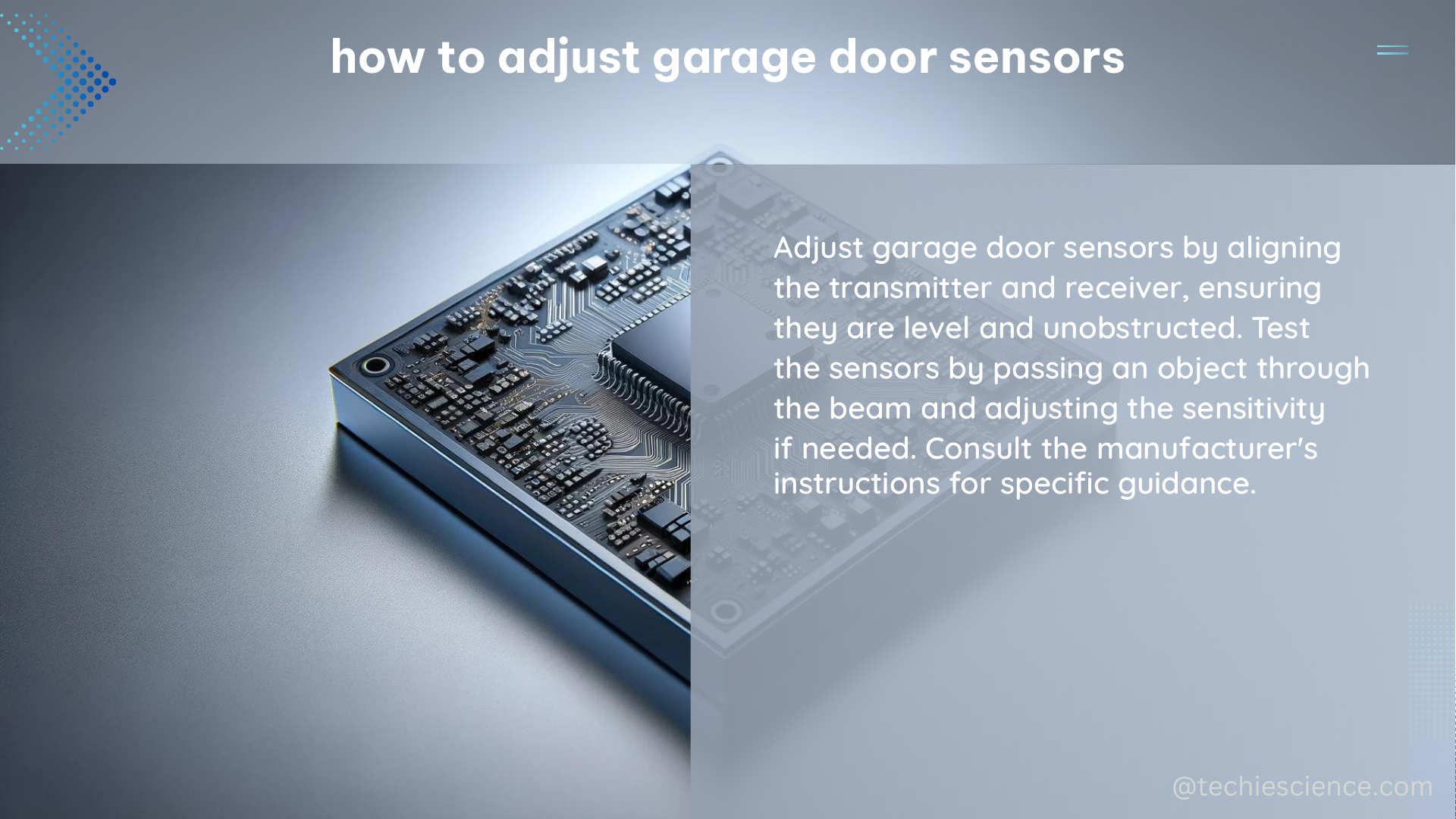Adjusting garage door sensors is a crucial task to ensure the safe and reliable operation of your garage door. Properly aligned and functioning sensors can prevent accidents and protect your property. This comprehensive guide will walk you through the step-by-step process of adjusting garage door sensors, providing you with the technical details and expert insights to ensure your garage door operates seamlessly.
Aligning the Sensors
-
Sensor Positioning: The garage door sensors should be positioned facing each other, with a distance of 6 to 12 inches between them. This distance ensures the sensors can effectively detect objects in the door’s path. Measure the distance between the sensors using a ruler or tape measure to ensure they are within the recommended range.
-
Sensor Angle: The sensors should be angled slightly downward, with a tilt of approximately 5 to 10 degrees. This angle helps the sensors detect objects at different heights, including small pets and children. Use a protractor to measure the angle and adjust the sensors accordingly.
-
Sensor Height: The sensors should be mounted at a height of 4 to 6 inches above the ground. This positioning ensures the sensors can detect objects of various sizes, including low-profile vehicles and small children. Use a measuring tape to verify the sensor height and make any necessary adjustments.
-
Sensor Alignment: Once the sensors are positioned correctly, use a level to ensure they are perfectly aligned with each other. Slight misalignment can cause the sensors to malfunction or fail to detect objects in the door’s path. Adjust the sensors until they are perfectly level and facing each other.
Checking the LED Lights

-
Solid LED Lights: When the sensors are properly aligned and detecting an object in their path, the LED lights on the sensors should be solid and steady. This indicates that the sensors are functioning correctly and communicating with the garage door opener.
-
Blinking LED Lights: If the LED lights on the sensors are blinking, it could indicate a problem with the sensor alignment or the presence of an obstruction in the door’s path. Carefully inspect the sensors and their surroundings to identify and resolve the issue.
-
LED Light Troubleshooting: If the LED lights are not illuminating at all, check the power supply to the sensors and ensure the wiring is secure and undamaged. If the issue persists, consult the manufacturer’s instructions or seek professional assistance.
Cleaning the Sensors
-
Sensor Surface: Over time, dirt, dust, and debris can accumulate on the surface of the garage door sensors, affecting their ability to detect objects. Use a soft, lint-free cloth to gently wipe the sensor lenses, ensuring they are clean and free of any obstructions.
-
Sensor Housing: In addition to the sensor surface, inspect the sensor housing for any signs of damage or corrosion. Clean the housing with a damp cloth and dry it thoroughly to prevent moisture-related issues.
-
Sensor Connections: Check the connections between the sensors and the garage door opener, ensuring they are secure and free of any damage. Tighten any loose connections and replace any damaged wiring to maintain a reliable sensor system.
Verifying Sensor Operation
-
Sensor Detection Test: Once the sensors are aligned, cleaned, and the connections are verified, test the sensors by placing an object in their path. The LED lights should illuminate, indicating that the sensors are detecting the object and communicating with the garage door opener.
-
Sensor Range: Garage door sensors typically have a detection range of 6 to 12 inches. Verify the sensor range by placing objects at various distances and ensuring the sensors can reliably detect them.
-
Sensor Sensitivity: Most garage door sensors can detect objects up to 1.5 inches in diameter. Test the sensor sensitivity by placing objects of different sizes in their path and ensuring the sensors can reliably detect them.
-
Sensor Responsiveness: The sensors should respond quickly to the presence of an object in their path, preventing the garage door from closing and potentially causing damage or injury. Observe the sensor response time and ensure it meets the manufacturer’s specifications.
By following these detailed steps and technical specifications, you can effectively adjust your garage door sensors to ensure their proper alignment, cleanliness, and optimal performance. Remember to always consult the manufacturer’s instructions and seek professional assistance if you encounter any issues or concerns during the adjustment process.
References:
- Federal Motor Vehicle Safety Standards; Rear Visibility. (2014, April 7). Retrieved from https://www.federalregister.gov/documents/2014/04/07/2014-07469/federal-motor-vehicle-safety-standards-rear-visibility
- Lessons Learned from Case Studies of Six High-Performance Buildings. (2006). Retrieved from https://www.nrel.gov/docs/fy06osti/37542.pdf
- Digital Habit Evidence. (2022, December 16). Retrieved from https://scholarship.law.duke.edu/cgi/viewcontent.cgi?article=4144&context=dlj
- Internet of Things For Dummies®, Qorvo 2nd Special Edition. (2021). Retrieved from https://www.rfmw.com/data/qorvo-iot-for-dummies-2nd-edition.pdf
- Performance Improvement Guide. (n.d.). Retrieved from https://www.dcms.uscg.mil/Portals/10/CG-1/cg111/docs/HPM/Wellness%20Wednesday/PIG_6th_Edition-FINAL.pdf?ver=WiMF2s3E3-Ckz9FOjQdoow%3D%3D

The lambdageeks.com Core SME Team is a group of experienced subject matter experts from diverse scientific and technical fields including Physics, Chemistry, Technology,Electronics & Electrical Engineering, Automotive, Mechanical Engineering. Our team collaborates to create high-quality, well-researched articles on a wide range of science and technology topics for the lambdageeks.com website.
All Our Senior SME are having more than 7 Years of experience in the respective fields . They are either Working Industry Professionals or assocaited With different Universities. Refer Our Authors Page to get to know About our Core SMEs.